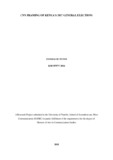| dc.description.abstract | The study sought to investigate the framing of Kenya’s 2017 election by Cable News Network. Its objectives were: to investigate prominent issues and themes in the stories; to investigate dominant frames in the stories; to identify dominant words, phrases and images; and to identify common news sources in the coverage. The study was based on the Framing Theory. The sample was drawn from 65 video and text stories on Kenya’s 2017 elections that were published by Cable News Network on its website between March 2017 and March 2018. A total of 33 stories – 17 text stories and 16 video stories -- were purposively sampled and analysed. The stories were analysed to identify prominent themes, dominant frames, common keywords and phrases, contents of images and sources of the news. The study found that the dominant frames of Kenya from coverage of the 2017 elections by Cable News Network were those of a poor and violent society. Kibera Slums was the most common setting, accounting for 55 per cent of video stories. Violent protests and confrontations with anti-riot police were recorded in 22 per cent of the images, emphasising the violent frame. The most common keywords and phrases appearing in the stories used in an unfavourable context were: ‘violence/ protests’, ‘absence of democracy and rule of law’, ‘election irregularities’, ‘credible/ free and fair elections’, ‘peace/ calm’, and ‘East Africa’s biggest economy/ regional hub’. The main news sources for the stories were local individuals, mostly elite and included politicians, analysts, and observers, contrary to early research that has found that foreign sources are most often quoted by foreign correspondents. This study recommends that CNN enhances its reporters in Kenya in order to be able to cover different aspects of the Kenyan story. It also makes a case for diversification of sources quoted in stories in order to address the over-reliance on a few elite sources for stories. It also recommends use of a variety of settings for stories to show different aspects of Kenyan life. This study forms a basis for further research to identify commonalities and differences in frames taken by other major foreign press outlets in their coverage of the elections; and contrasting this against frames taken by local media. This will contribute towards interrogating foreign press’ representation of Africa because it contributes significantly towards its image and reputation on the global stage, which has economic importance, particularly in attracting foreign direct investment and tourists. | en_US |



